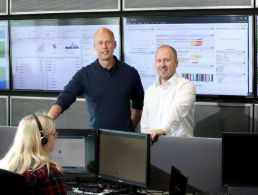To celebrate Science Week, we asked some science communication superstars for their best tips for public engagement.
It’s Science Week across Ireland, which means Science Foundation Ireland (SFI) has ramped up public engagement with events and outreach happening around the country.
As a discipline, science communication is increasingly recognised as integral to the progress of science by engaging public support and encouraging science in society. But what makes for good science communication? And how can someone get started?
We asked a panel of experts to weigh in with their top tips.
Connect with curiosity
“When you’re communicating your research in any format – be it in person, via email, on radio etc – prepare in advance by first asking yourself: why should anyone else care?” said Sylvia Leatham, public engagement manager at I-Form, the SFI research centre for advanced manufacturing.
“Use empathy to put yourself in the shoes of the audience. What do they currently know about your topic? What do they need to know now?
“Remember, we are all humans, and that doesn’t go away just because you are talking about research or science. Connect with whoever you are talking to as a fellow curious human. We are all curious by nature!”
Put yourself and your audience at ease
Catherine McGuinness never studied communications, but with a science degree and PhD from University College Dublin, along with an exceptional talent for communicating and connecting with audiences, she can be found engaging in science communication activities across Ireland.
“The most important thing to remember is that you are having a conversation, not giving a lecture,” she advised.
“As trained scientists, we’re taught to defend ourselves in vivas, conferences and poster sessions. In the academic world your audience are critical – that’s the scientific process: picking holes in what you are saying and trying to prove you’re wrong.” This, McGuinness explained, leads to a deep-seated fear of vocally critical audiences, though that’s not how it plays out in her experience.
“With a public audience they want to learn, find out something they didn’t know before – and maybe be entertained along the way. It’s no accident that our greatest ever science communicator – David Attenborough – is so successful and so loved by the public. He holds the unique ability to deliver a complex biological phenomenon with such ease that the audience doesn’t even realise they are watching a science programme.”
Keep it real
“Enthusiasm is great but it’s important to be real when it comes to science communication as, otherwise, people will get disillusioned with all the hype and announcements,” said Maria Delaney, an award-winning science and health journalist currently working on investigative projects with Noteworthy.
“This is especially important for health-related science, as so many ‘potential cures’ are promoted by university press offices when in fact they are early-stage research on cells or animal models, which often don’t translate to human trials.
“You can communicate science without succumbing to false promises,” she added.
Don’t underestimate the power of jokes
Dr Jessamyn Fairfield, who helms Bright Club Ireland, a stand-up comedy night for researchers and academics, recommended science communication with a sense of humour.
“We don’t always need to take ourselves so seriously to get others to listen. Besides, both science and comedy are about upending existing frameworks, about creative changes to the status quo. Don’t be afraid to be funny!” she said.
“When people listen to comedy, they are more open and inquisitive – because a punchline is literally a change of mind, where you see a story from a new perspective. Talking about science using humour is really powerful for this reason, even (and perhaps especially) if you work on topics that people feel strongly about, like climate change.”
Don’t be afraid to be wrong
Laura Tobin – AKA Laser Laura, one of the organisers of Dublin Maker – would like science communicators to acknowledge the trial and error aspect of science more often.
“Don’t be afraid to talk about the things that have gone wrong,” she said. “There is a myth that scientists know the answers to everything when the reality is there’s a lot of failure and learning from things that don’t work.”
Design for everyone
Tobin also spoke to the need to be relatable to those beyond the standard STEM stereotypes. She recalled a visit to her school from scientists and engineers who all had a similar successful academic background, including A1s in Leaving Cert applied maths. “We had never heard of that subject because our girls school didn’t offer it,” she explained.
To combat such missteps, fellow science communicator Dr Claire Murray said we can “drive towards inclusive science communication by design, so that everyone can be heard and can participate – both in terms of who is delivering the sci-comm but also in terms of who is engaging”.
For example, Murray’s project at this year’s Dublin Maker festival – an escape room based on the periodic table – included a step stool so both small children and little people could engage with the display if they wanted to. “We also had large-print periodic tables to improve visibility,” she said.
Another example of this is the introduction of Irish Sign Language interpreters to events such as Fairfield’s Bright Club.
“You should be thinking about who is not in the room and why that might be,” added Murray. “These are all small things but they help to make sci-comm better and more inclusive, which is always good.”
Try everything
Finally, we turned to Dr Muriel Grenon, one of the winners of this year’s SFI award for Outstanding Contribution to STEM Communication. An advocate for scientists’ duty to engage the public, Grenon encouraged anyone interested to get involved with one of the many existing programmes that will show them there is more to science communication than a three-minute talk.
The founding director of Cell Explorers, a hands-on biology engagement programme for young children and families, Grenon said that aspiring science communicators should accumulate experience in all aspects of a programme, honing their skills across the board. Through experimenting with different roles in different programmes, you can find what suits you.
“Not everyone is good at TED Talks, not everyone likes to be on stage, not everyone likes public-speaking competitions, not everyone likes to run activities with children – however, if you don’t try, you will never know!” she explained.
Once you’ve figured that out through experience, you’ll be ready to design your own activity, run your own event, or mentor others in public engagement.
“The perfect sci-comm/public engagement activity for you is the one that you enjoy, that you are good at and that people like you to do. It is the one that will make you happy and successful in engaging the public,” said Grenon.




